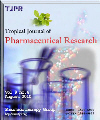
|
Tropical Journal of Pharmaceutical Research
Pharmacotherapy Group, Faculty of Pharmacy, University of Benin, Benin City, Nigeria
ISSN: 1596-5996
EISSN: 1596-5996
Vol. 15, No. 12, 2016, pp. 2611-2618
|
 Bioline Code: pr16343
Bioline Code: pr16343
Full paper language: English
Document type: Research Article
Document available free of charge
|
|
|
Tropical Journal of Pharmaceutical Research, Vol. 15, No. 12, 2016, pp. 2611-2618
| en |
Evaluation of neuroprotective properties of two synthetic prenylated xanthone analogues against paraquat and 6- hydroxydopamine toxicity in human neuroblastoma SHSY5Y cells
Nga, Alan Koh-Siong; Tho, Lai-Yeng; Lim, Cheng-Hoe; Lim, Chan-Kiang & Say, Yee-How
Abstract
Purpose: To investigate whether two synthetic prenylated xanthone analogues - 1,3,6,8-tetrahydroxy-9H-xanthen-9-one (SX1) and 1,3,6-trihydroxy-2-(3-methylbut-2-enyl)-9H-xanthen-9-one (SX2) - are
potential candidates for neuroprotection against paraquat- and 6-hydroxydopamine (OHDA)-induced
human neuroblastoma SH-SY5Y cell death.
Methods: SH-SY5Y cells were treated with SX1 and SX2, and the maximum non-toxic dose (MNTD)
were obtained by 3-(4,5-dimethylthiazol-2-yl)-2,5-diphenyltetrazolium bromide (MTT) assay. MTT assay
was also used to assess the ability of MNTD and half MNTD (HMNTD) doses of SX1 and SX2 to protect
against the neurotoxicity of 200 μM paraquat and 100 μM 6-OHDA. Intracellular ROS production by SHSY5Y
cells treated or untreated with SX1 or SX2 was measured by dichloro-dihydro-fluorescein
diacetate (DCFH-DA) assay.
Results: SX1 and SX2 MNTDs at concentrations of 1850 nM and 105 nM, respectively, did not
significantly (p > 0.05) provide neuroprotection against paraquat-induced SH-SY5Y cell death. Only SX2
MNTD and HMNTD significantly (p < 0.05) protected SH-SH5Y cells against 6-OHDA-induced cell death
by 10 and 17 % improved cell viability. Although intracellular ROS production was significantly
attenuated by SX1 HMNTD and MNTD, this did not improve cell viability against paraquat-induced cell
death.
Conclusion: These results reveal that SX2 confers neuroprotection on 6-OHDA-induced SH-SY5Y
neurotoxicity. Further investigations to elucidate the detailed molecular mechanisms of neuroprotection
by SX2 are warranted.
Keywords
Prenylation; Xanthone derivatives; Neuroprotection; Paraquat; Dopamine; Neurotoxicity; Human neuroblastoma SH-SY5Y cell; 6-Hydroxydopamine
|
| |
© Copyright 2016 - Pharmacotherapy Group, Faculty of Pharmacy, University of Benin, Benin City, 300001 Nigeria.
Alternative site location: http://www.tjpr.org
|
|
